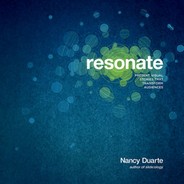78 Resonate
A big idea is that one key message you want to commu-
nicate. It contains the impetus that compels the audi-
ence to set a new course with a new compass heading.
Screenwriters call this the “controlling idea.” It has also
been called the gist, the take-away, the thesis statement,
or the single unifying message.
There are three components of a big idea:
ONE A big idea must articulate your unique point of
view. People came to hear you speak; since they want
to know your perspective on the subject, you should
give it to them. For example, “the fate of the oceans”
is merely a topic; it’s not a big idea. “Worldwide pollu-
tion is killing the ocean and us” is a big idea that has a
unique point of view. The big idea doesn’t have to be
so unusual that no one has ever heard of it before. It
just needs to be your point of view on the subject
rather than a generalization.
TWO A big idea must convey what’s at stake. The
big idea should articulate the reason why the audience
should care enough to adopt your perspective. You
could say your idea is to “replenish the wetlands through
new legislation.” But compare that to “Without better
legislation, the destruction of the wetlands will cost the
Florida economy $70 billion by 2025.” Conveying what’s
at stake helps the audience recognize the need to partici-
pate and become heroes. Without a compelling reason
to move, a big idea falls flat.
THREE A big idea must be a complete sentence. Stating
the big idea in sentence form forces it to have a noun
and a verb. When asked the question “What’s your pre-
sentation about?” most people respond with something
like “It’s the third-quarter update” or “It’s about new
software.” These are not big ideas. A big idea has to be
The Big Idea
a complete sentence: “This software will make your team
more productive and generate a million dollars in revenue
over two years.” It’s even better if the word “you” is used
in the sentence; that ensures that it’s written to someone.
Emotion is another important component to the big idea.
Boiling down all of the various emotions simplifies this
task. Ultimately, there are only two emotions—pleasure
and pain. A truly persuasive presentation plays on those
emotions to do one of the following:
Raise the likelihood of pain and lower the likelihood of •
pleasure if they reject the big idea.
Raise the likelihood of pleasure and lower the likelihood •
of pain if they accept the big idea.
1
For example, a business presentation that centers on
“We are losing our competitive advantage” as its big
idea has nothing at stake. In contrast, the message “If we
don’t regain our competitive advantage, your jobs are in
jeopardy” makes it clear that there’s plenty at stake! It
appeals to employees’ human instinct to survive. Humans
change when there is a threat and sense of urgency. In
the January 2007 issue of Harvard Business Review, John
P. Kotter explained that “most successful change efforts
begin when some individuals or groups start to look hard
at a company’s competitive situation, market position,
technological trends, and financial performance. They
then find ways to communicate this information broadly
and dramatically, especially with respect to crises, poten-
tial crises, or great opportunities that are very timely.”
2
The gravity of the presentation should match the severity
of the situation and accurately reflect what’s at stake—no
more, no less.
CH004.indd 78CH004.indd 78 8/16/10 4:06:05 PM8/16/10 4:06:05 PM

THESE ARE NOT BIG IDEAS THESE ARE BIG IDEAS
Lunar Mission The United States should lead
in space achievement because
it holds the key to our future
on Earth.
Client Sales Call Our software gives your cus-
tomers access to their records,
which saves your employees
time and increases your mar-
gins by 2 percent.
Third-Quarter Update Third-quarter numbers are
down; and to stay in the game,
every department needs to
support the sales initiative.
JFK knew that no one could predict the
outcome of the space race, but he believed
it would determine who wins the battle
between freedom and tyranny.
A Big Idea
YOUR UNIQUE
POINT OF VIEW
ON A TOPIC
A CLEAR STATEMENT
OF WHAT’S AT STAKE
FOR THOSE WHO DO
OR DON’T ADOPT YOUR
POINT OF VIEW
WRITTEN IN
THE FORM OF
A SENTENCE
Define the Journey 79
CH004.indd 79CH004.indd 79 8/16/10 4:06:06 PM8/16/10 4:06:06 PM
..................Content has been hidden....................
You can't read the all page of ebook, please click here login for view all page.
